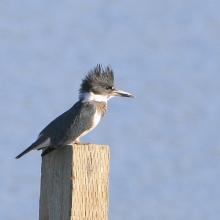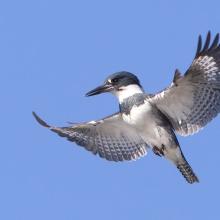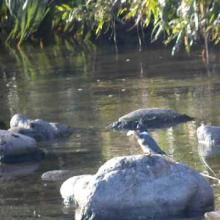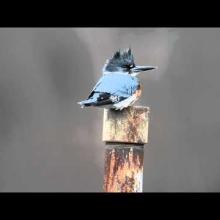

Join BirdNote tomorrow, November 30th!
Illustrator David Sibley and actor H. Jon Benjamin will face off in the bird illustration battle of the century during BirdNote's Year-end Celebration and Auction!
What is the loudest bird on Earth? An irritated male Belted Kingfisher is a good candidate, especially if you are next to a perched bird uttering his piercing scream-rattle. There’s a good evolutionary explanation for being such a loudmouth: announcing to your competitors that this is your turf, your breeding territory — Other Kingfishers Keep Out.

Belted Kingfisher male (left) and female © Trudy Nicholson
Kingfishers need to eat a lot of prey each day from a smorgasbord of fish, frogs, and crayfish, in order to meet their daily energy requirements. So controlling a suitable stretch of river or canal or other body of water, protecting it from competing birds, is important in the ultimate goal of producing healthy offspring that carry on the genes of the parents.
Belted Kingfishers have a presence about them. There’s the powder blue-grey plumage, fierce beak, and a head crest that gives the bird a look of a permanent bad-hair day. Most impressive is its robust build, reminiscent of a once-skinny but pugnacious hummingbird that has spent a lot of time at the gym.
We have only one species of kingfisher throughout the United States. Two others — the Ringed Kingfisher and the Green Kingfisher — creep into the southwestern part of the country, particularly South Texas. Heading south into the tropics doesn’t jack up the total very much, as it usually does in other lineages. For some reason, the Amazon rainforest, exuberantly rich in so many other taxa, missed the boat when it comes to diversity of kingfishers. There's but a handful and they all look alike, being slightly larger or smaller versions of each other. The reason for the lack of speciation in new world rainforest kingfishers remains a puzzle to biologists.
It’s when you travel to Africa and, to an even greater extent, the islands known as Australasia, that the kingfishers explode in all their diversity, glory, and plumage. Of the 87 species of kingfishers, New Guinea boasts the most. But many islands of that region — Sulawesi, Mindanao, Bougainville, Guadalcanal, Vanuatu, Tahiti — have their very own species found nowhere else. So here is a great lesson of biogeography, the science of the distribution of plants and animals: our lone kingfisher species is a kind of rarity. It’s widespread and common, while most of its close relatives have very narrow ranges and small populations. And unlike our Belted version, most don’t feed over water but inland. They are truly forest or savanna birds, hunting insects and other invertebrates. And many are not as boisterous as our Belted Kingfisher, offering softer calls, or in the case of the Common Kingfisher (found across Eurasia and North Africa), hardly any call at all.
Come to think of it, the loudest bird in the world, perhaps adjusted for body size, may be the Laughing Kookaburra, the Australian cousin of the Belted Kingfisher and an even more robust member of the kingfisher family. Or it could be the Screaming Piha, a bird of the Amazon rainforest. Have you ever watched a Tarzan film or any motion picture set in a tropical rainforest? Chances are the sounds weren't really local but instead the evocative vocals of the Screaming Piha or the hysterics of the Laughing Kookaburra. Their songs personify wildness. When I listened to the Laughing Kookaburra in a forest near Sydney, it struck me as the perfect greeter at the gates of Hell.
Our local kingfisher has no interest in auditioning for such a role, minding its territory along the locks of the Potomac, looking for its next easy meal.
###

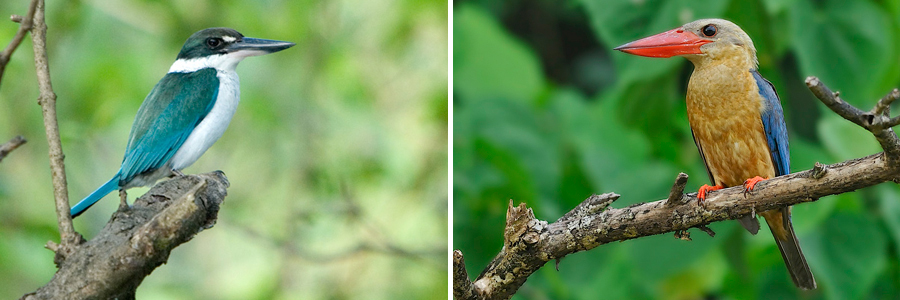

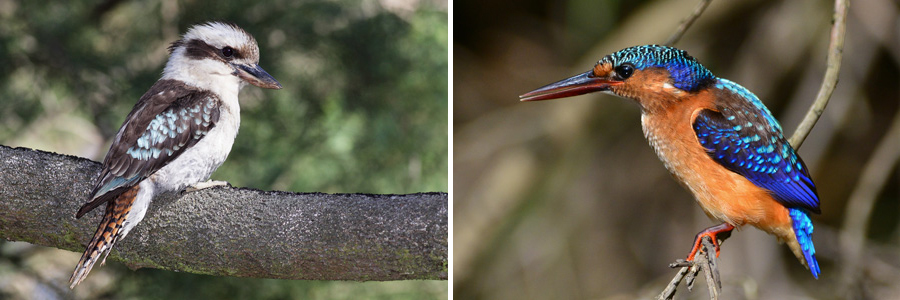
Ringed Kingfisher in Brazil © Tambako The Jaguar;
Pied Kingfisher in India © Koshy Koshy
Collared Kingfisher in India © Sergey Yeliseev;
Stork-billed Kingfisher of Borneo © Mark Louis Benedict
Woodland Kingfisher in Botswana © Tarique Sani;
White-throated Kingfisher in Singapore © Lip Kee
Laughing Kookaburra © Leo;
Malachite Kingfisher in South Africa © Ian White
Check out these BirdNote shows about the Belted Kingfisher & other kingfishers: 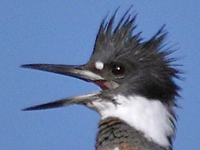 The Burrowing Belted Kingfisher Biomimicry - Japanese Trains Imitate Kingfisher Adapted from an article that originally ran in The Village News. |



